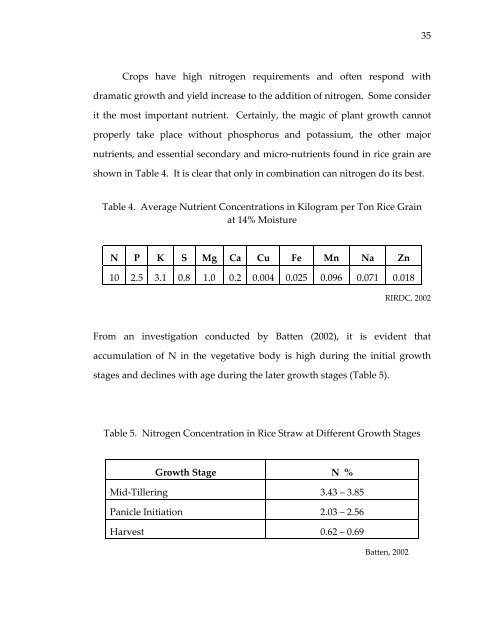Management of rice production systems to increase productivity
Management of rice production systems to increase productivity
Management of rice production systems to increase productivity
Create successful ePaper yourself
Turn your PDF publications into a flip-book with our unique Google optimized e-Paper software.
Crops have high nitrogen requirements and <strong>of</strong>ten respond with<br />
dramatic growth and yield <strong>increase</strong> <strong>to</strong> the addition <strong>of</strong> nitrogen. Some consider<br />
it the most important nutrient. Certainly, the magic <strong>of</strong> plant growth cannot<br />
properly take place without phosphorus and potassium, the other major<br />
nutrients, and essential secondary and micro‐nutrients found in <strong>rice</strong> grain are<br />
shown in Table 4. It is clear that only in combination can nitrogen do its best.<br />
Table 4. Average Nutrient Concentrations in Kilogram per Ton Rice Grain<br />
at 14% Moisture<br />
N P K S Mg Ca Cu Fe Mn Na Zn<br />
10 2.5 3.1 0.8 1.0 0.2 0.004 0.025 0.096 0.071 0.018<br />
35<br />
RIRDC, 2002<br />
From an investigation conducted by Batten (2002), it is evident that<br />
accumulation <strong>of</strong> N in the vegetative body is high during the initial growth<br />
stages and declines with age during the later growth stages (Table 5).<br />
Table 5. Nitrogen Concentration in Rice Straw at Different Growth Stages<br />
Growth Stage N %<br />
Mid‐Tillering 3.43 – 3.85<br />
Panicle Initiation 2.03 – 2.56<br />
Harvest 0.62 – 0.69<br />
Batten, 2002
















